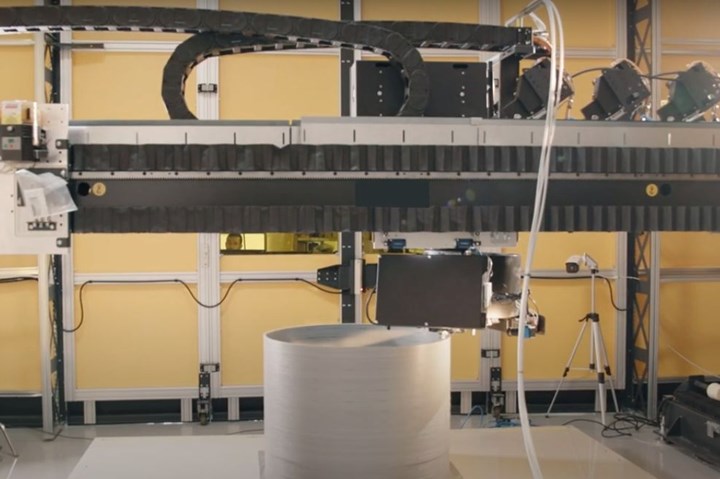
Large-Format “Cold” 3D Printing With Polypropylene and Polyethylene

Largix’s Production Solution large-format 3D printer makes it possible to print with PP and PE materials with minimal shrinkage, by softening the exterior — but not melting — the filament. Screenshot: Largix from video
When Ronen Orr and Amir Sheelo began the collaboration that would become Largix
“We did not start by developing a technology and looking for a market,” Sheelo says. “In commercial products, it’s all about quality standards and materials. That’s where we started.”
The Israel-based startup is in the process of launching a new polymer 3D printing technology targeted for the production of industrial products, specifically heavy-duty products made of polypropylene and polyethylene (PP and PE). These materials account for 50 to 60% of global polymer consumption, Sheelo says, but they have historically been difficult to 3D print. The plastics can expand up to 30% in a molten state and will retract an equal amount when cooled and solidified; this dynamic behavior makes it difficult to avoid warpage and maintain dimensions in a 3D printing process that relies on melting such as fused filament fabrication (FFF).
3D Printing with Square Filament
To avoid these challenges, Largix has developed a 3D printing process that mostly keeps the polymer in its solid state. Instead of melting and extruding the filament, the printer uses a laser beam to melt just the outer “skin” of each strand so that it can attach to previous and adjacent layers. Up to four filaments can feed through the printhead at once, all of them laser-softened in unison, allowing for rapid material buildup. The company produces the feedstock itself, which has a square profile to maximize the surface area for bonding. The technique creates a monolithic part with Z-axis strength above 90%, Sheelo says.
(And that monolithic part can contain multiple materials, he notes. While up to four filaments can be feed through the printhead at once, there is no need for all of them to be identical. It could be possible, for instance, to build a wall that has colored polypropylene for aesthetics only on one (external) side, then a glass fiber-reinforced filament for strength, then a recycled PP filament, and a fourth filament with some other enhancement like a UV stabilizer additive. As long as the base material is the same, the filaments will weld and function together similar to plain PP.)
Cold 3D Printing and Hybrid Manufacturing
This “cold” 3D printing process is offered on the company’s Production Solution machine. The gantry-based printer is totally modular and offers a large build volume; the machine running at Largix’s headquarters has a build volume of 4 by 3 by 3 meters (limited vertically only by the facility’s ceiling height) but can be customized to the needs of the user. The automated platform can be equipped with multiple printheads as well as a robotic arm for CNC milling, making it a hybrid manufacturing system.
Because the material remains relatively cool and solid throughout printing, machining can be done in sequence, without the need to wait for the printed material to cool or contract first. With just a few hours of setup, one Production Solution can run for several days largely unattended, as long as it is kept stocked with material. The company projects that each Production Solution could consume between 120 and 150 tons of material per year.
“This is autonomous, nonstop production,” Sheelo says. The machine reduces both the need for skilled workforce and the amount of manual labor required to produce industrial parts. And the company already has an initial industrial niche in mind: custom chemical storage tanks
Digital Production of Chemical Storage Tanks
When mass produced, these tanks are made through rotational molding with reusable tooling. But custom chemical tanks require a far more manual process, which today is performed by many discrete companies in various regions of the world. Largix believes its manufacturing system and materials offer a digital alternative to fabricating these tanks by hand, along with the ability to create variable wall thickness and other geometries that would be difficult or impossible to produce manually.

Large, custom chemical storage tanks like this one could be made faster and through a more automated process with the Largix 3D printer. Screenshot: Largix from video
Its first beta tester, a tank manufacturer in Israel, currently fabricates custom tanks in 50 to 60 hours through manual means. With the Production Solution set to arrive in spring of 2023, this company expects to be able to produce each custom tank in just 2 to 3 hours on this platform.
Chemical tanks won’t be the only application for Largix, of course. The company is already working on applying its technology to produce custom concrete molds, another industrial product today largely built by hand. Parts for aviation, automotive, construction, architecture and other industries will follow.

Leave a Reply